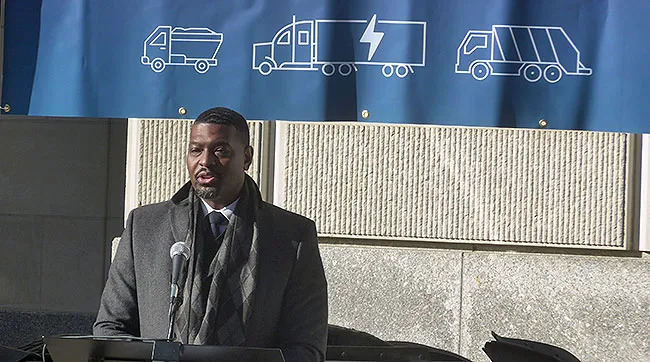Staff Reporter
EPA to Tighten Nitrogen Oxide Limits for New Heavy Trucks

[Stay on top of transportation news: Get TTNews in your inbox.]
WASHINGTON — The Environmental Protection Agency on Dec. 20 announced more stringent clear-air standards for heavy trucks that the agency said are 80% stronger than current limits.
Starting with model year 2027 trucks, the EPA’s new standards — the first update to its heavy-truck rules in more than two decades — will by EPA estimates reduce nitrogen-oxide emissions from trucks by more than 40% by 2040 and by nearly 50% by 2045, at which point it projects most of the regulated fleet will have converted to newer equipment.
The final, 1,153-page rule includes provisions that require emissions equipment to perform in compliance with clean air limits for a longer period of time. It also requires manufacturers to demonstrate that engines are designed to prevent tampering with emission-control components by limiting access to electronic pollution controls prone to tampering.
Per the EPA, the new rule will increase the “useful life” of governed vehicles by 1.5-2.5 times, and result in emission warranties that are 2.8-4.5 times longer than current ones.
During an outdoor event held for the announcement, EPA Administrator Michael Regan said the rule is the first step in the agency’s broader Clean Trucks Plan. He stressed that this NOx rule was made as strong as possible, done as soon as possible and crafted for a time period as long as possible. The final rule is called “Control of Air Pollution from New Motor Vehicles: Heavy-Duty Engine and Vehicle Standards.” Regan signed it at the event.

EPA Administrator Michael Regan speaks at the outdoor event. (Noël Fletcher/Transport Topics)
“I’m so proud to announce that EPA has finalized the strongest ever national standards that will reduce smog and nitrogen-oxide emissions from heavy-duty vehicles and engines,” he said. “Because of our collective work, this rule will result in widespread improved air quality across the United States, especially in communities near major roadways that are over-burdened by air pollution.”
Regan noted the effort was a collaborative process with various stakeholders. In particular, he thanked Daimler Trucks North America and Volvo Truck North America, both of which were on hand and had trucks on display.
Also on hand was Sen. Tom Carper (D.-Del.), chairman of the Senate Committee on Environment and Public Works, who described the new standards as “a gift that will keep on giving” for future generations. “The transportation sector is one of our nation’s greatest sources of air pollution,” he said. “Our heavy-duty vehicles, trucks and buses make up nearly one quarter of all U.S. transportation emissions.”

Sen. Tom Carper calls the new standards “a gift that will keep on giving” for future generations. (Noël Fletcher/Transport Topics)
In a statement issued shortly after the EPA announcement, American Trucking Associations President Chris Spear noted that the trucking industry since 1988 has cut nitrogen-oxide emissions by more than 98%. He stressed that these efforts demonstrate the industry’s commitment to protecting the environment, and noted that further progress “will depend on standards that are technologically feasible with equipment that is cost-permitting and reliable for fleets.”
Spear said ATA is reviewing details of the new rule and assessing its impact on members.
Another aspect of the final rule involves maintenance and serviceability requirements that more clearly describe owner responsibilities for maintenance and use, and provide more information on how to diagnose and repair emission-control systems.
“We expect the new maintenance and serviceability requirements for manufacturers would help operators keep in-use engines and emission-control systems working properly to maintain their certified emission levels in the real world,” EPA said.
The agency also seeks to deter engine tampering and poor maintenance by requiring heavy truck makers “to design their engines to prevent operators from reprogramming the engine to bypass or disable emission controls.”
The agency acknowledged that the final rule may impact vehicle sales as purchase price adjustments may result from new equipment and longer emission warranty mileage requirements. The mandate, it said, may compel more “pre-buy” purchases of new vehicles before the rules take effect, and may also temper buying activity once trucks with the new equipment reach the market. Specifically, the agency’s research indicated pre-buy for Class 8 trucks may rise by up to 2% over a period of up to 8 months before the 2027 standards begin. It also projected sales may decline by as much as 3% for up to 12 months after the standards take effect.
However, EPA doesn’t foresee the rules shifting freight-hauling activity away from trucks. “We expect little mode shift due to the final rule because of the large difference in cost of moving goods via trucks versus other modes of transport (e.g., planes or barges),” it said.
In his statement, Spear noted, “While truck engine emission standards are directed at manufacturers, it is the purchasing decisions of fleets that ultimately determine their success or failure.”
Upcoming steps in EPA’s Clean Trucks Plan in the coming months include the planned release of proposed so-called “Phase 3” greenhouse gas standards for heavy-duty vehicles, and also proposed multipollutant standards for light- and medium-duty vehicles. Both of these would also target model year 2027 vehicles.
In addition, EPA said it intends to issue final decisions in early 2023 regarding several waiver requests from California for the state’s heavy-duty vehicle and engine emission standards.
Spear urged caution regarding the state’s efforts.
“ATA remains extremely concerned over the potential growth of state patchworks of NOx emission standards that will create havoc for an industry that operates across local, state and international boundaries,” he said in his statement. “We hope EPA and the California Air Resources Board will ultimately agree to a uniform, single standard that best achieves our nation’s environmental goals.”
Want more news? Listen to today's daily briefing below or go here for more info:




